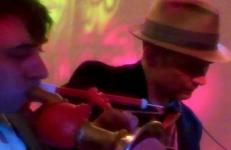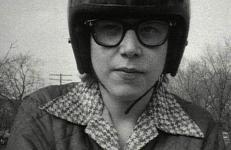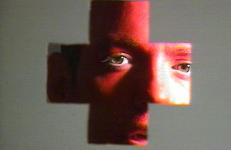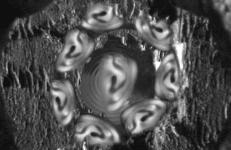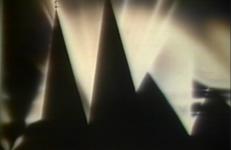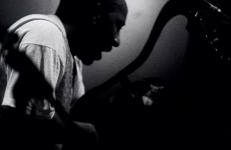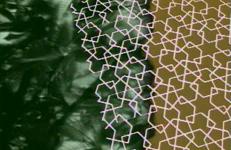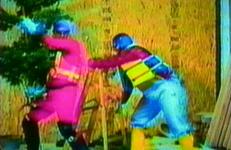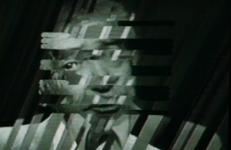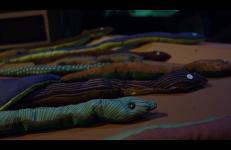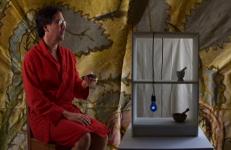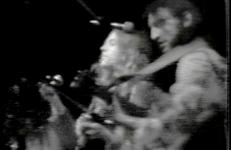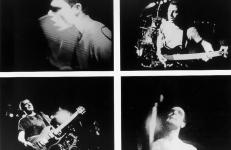This is a colorful fable of many foibles involving a man of the cloth who wishes to shed those accouterments for something of a more sinister fabric. The plot tumbles unrelentingly toward a sci-fi tone when a time machine is thrown into the vivid melange and our anti-hero gets caught up with an ancient soul who has the hots for less ancient hunks. There’s spectacle on a budget and young and old doing their best to put on a big show about the sacred, the profane and the goofy.
Music
Free Society is a short experimental music video that juxtaposes images of police harrassment in the U.S. with images of the military quelling revolutionary opposition. Includes comments from televangelist Jerry Falwell.
This title is also available on Paul Garrin Videoworks: Volume 1.
Silver directs and performs all the roles in this raucous and hilarious music video rendition of Lynyrd Skynyrd’s "Freebird", the infamous Southern rock anthem for an entire generation of 1970s male youth. In this spoof of straight mass culture, Silver flips ironically between roles; from a lesbian proudly proclaiming her sexuality at the Academy Awards, to an in-concert Coors-drinking Ronnie Van Zant, and, finally, to a black-lace lesbian lounge swinger celebrating the wild, colorful world of “out” visibility.
From The Files of the Pyramid Cocktail Lounge is a series of video clips taken at the Pyramid Club, a seminal location for the East Village drag scene in the midst of the club's most influential years. While rummaging through a file cabinet full of event fliers from the Pyramid Club, an office worker in drag guides the viewer through video documentation of past performances at the club.
Shot in black and white Super 8, this lyrical short follows a wandering, disengaged youth through grey afternoons. German Song features the hard-edged music of Come, an alternative band from Boston.
Turn the lights down / Way down low / Turn up the music / Hi as fi can go / All the gang's here / Everyone you know / It's a crazy scene / Hey there, just look over your shoulder / Hoo hoo / Get the picture? / No no no no / Yeah / Walk a tight rope / Your life-sign line / Such a bright hope / Right place, right time / What's your number? / Never you mind / Take a powder / But hang on a minute, what's coming round the corner? Wooooo woo woo / Have you a future? / No no no no / Yeah
An erotic/mystical misadventure in which the allure of the religious path is strewn with earthly temptations. Struggling with a bogus Zen koan involving flowers in keyholes and jumping through windows, the protagonist will end up entering, by the conclusion, the realm of subatomic particles, thereby achieving transcendence-of-a-sort. On the soundtrack, operatic quotations comment ironically (and sometimes sincerely) on the visual proceedings.
A film titled Dance Movie (or, alternatively, Rollerskate) appears in many Warhol filmographies, but no work with this title has been found in the archive. The lost film, starring dancer Fred Herko, was shot in 1963. A year later, Herko leaped out of an open window while dancing to Mozart’s Coronation Mass in C Major. Inspired by descriptions of the missing film and the memoir of Herko’s best friend, the poet Diane Di Prima, Goddess of Speed poetically reimagines the last days of the young performer.
Painter and multi-media artist Jack Goldstein lived and worked in New York City. His airbrushed paintings of lightning and night skies are shown here accompanied by synthetic music, which the artist also composed. Goldstein committed suicide in 2003.
Interviewed by Jim Johnson.
With an all-female cast, featuring Suzie Bright as John Lennon, Cecilia Dougherty's Grapefruit plays with the romanticized history of the iconic Fab Four, gently mocking John and Yoko’s banal squabbles and obsessive rituals of self-display. Based obliquely on Yoko Ono’s book, the piece works on many levels to reposition this mythic tale of the Beatles by casting '80s women in mod drag—effectively mapping the lesbian sub-culture onto heterosexual mass culture.
A reflection on the phenomenon of the touring musician.
"I shot this film with a 16mm wind-up Bolex, and the 25th Anniversary tour of Dutch band The Ex, when they embarked on a 'convey tour' with about 25 performing comrades. If half the battle is getting there and half the battle is joy, then the other half is madness. I thank all of the musicians who float in and out — of the film, in particular, and my life, in general."
— Jem Cohen
Soundtrack music: Guitargument, an Andy Moor and Mia Clarke improvisation, arranged and edited by Jem Cohen.
A performer lip-synchs to archival audio featuring the voice of author and anthropologist Zora Neale Hurston as she describes her method of documenting African American folk songs in Florida. The flickering images were produced with a hand-cranked Bolex so that the lip-synch is deliberately erratic and the rear-projected, grainy, looped images of Masai tribesmen and women, recycled from an educational film, become increasingly abstract as the audio transforms into an incantation.
The University of Virginia gospel choir Black Voices returns home from a triumphant concert in Hampton Roads.
This title is only available on Can You Move Like This: Black Fire.
The University of Virginia gospel choir Black Voices returns home from a triumphant concert in Hampton Roads.
This title is only available on Can You Move Like This: Black Fire.
In this video diptych, Snyder uses image and music to depict opposing forces in semi-abstract terms. Exploring processes of fracture and permutation, Hard and Flexible Music contrasts two groups of images, gridded architectural structures and fluid natural imagery, on opposite sides of the screen. The experimental music soundtrack carries two synthesized tracks with differing musical qualities.
This title is also available on Bob Snyder: Sound and Video 1975-1990.
An alternative earth music video. An epic last stand. A portrait of two utilitarian workers engaging in a collaboration with Karen, manifesting improvisational geographic friendships...
This title is also available on HalfLifers: The Complete History.
The video hovers tentatively between therapy, documentary, poetics and mystic traipsery and ends, like all good things, in surrender to song. There is a challenge presented (the challenge to engage earnestly with the piece as it requests) to fall into the breathing and pacing presented, and the challenge to view the video as a discrete piece of art at the same time. The piece relies heavily on the text, the disembodied Virgil through which the words become musical, instructive and (due to the absence of image) visual.
A Sly and the Family Stone tarmac arrival as a point of departure.
This title is only available on Can You Move Like This: Black Fire.
A Sly and the Family Stone tarmac arrival as a point of departure.
This title is only available on Can You Move Like This: Black Fire.
The interior was delusional like any visual psyche. The couches and plants, rugs and paintings were all in cahoots and up in arms over the cahootery. The explorers were under-qualified and cowardly.
Using the image processor as it was intended as a performance instrument, Icron exploits the processor’s real-time capabilities: the image and soundtrack were generated through simultaneous improvisation, although the color was added later. The title of the piece is a neologism created by fusing "icon" with "chron" as a reference to the effect of temporal changes on images. Snyder combines iconographic elements of broadcast television with the structural features of music by deconstructing the face of a newscaster into scan lines.
In The Jungle playfully and sorrowfully tells the tale of an unreliable narrator in a self-imposed exile. Given a grant to study the equivalent of animal cries and whines in jungle flora our heroine has lived for 1,612 days deep in an unnamed jungle. This jungle serves as an extended metaphor for excessive and continual growth and death and fear and sustenance; a metaphorical space of chaos in which the scientist finds solace and which stands in contrast to the human jungle of 'civilization'.
"A chamber drama set in the confines of an apartment’s sun room, this video further explores visual themes and obsessions found in my earlier works and adds in a few new ones for good measure. Earlier motifs seen here are lightbulbs in pendulum movement, tabletop antics with simple household objects, Christo-like fleshy textures, sketchbook pages torn from their binders, book pages, bookshelves, and flowers. I play a vaguely Walter Mitty-ish figure, who imagines himself as a conductor, as Orpheus, and as conflicted characters in a Greta Garbo movie.
Shot in December 1969, this video documents a live performance by the Incredible String Band at the Fillmore East, NYC. Beginning with footage of people waiting in line at the doors before the show begins, the video goes on to record the performance itself. Early on, the band experiences some audio problems, before settling down to play. We witness the band talking, tuning their instruments and playing.
A collaboration between Jem Cohen and the Washington DC band Fugazi, the project covers the ten-year period following the band's inception in 1987. Far from a traditional documentary, the project is a musical document: a portrait of musicians at work.




